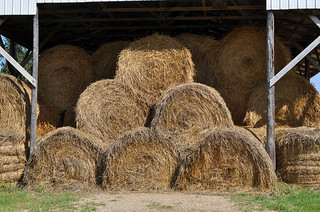Harvest index: A predictor of corn stover yield
Increased interest in harvesting corn stover for livestock feed or bioenergy has some farmers wondering how much stover is out there.
 Corn stover is made up of the stalk, leaves, husks and tassels left in the field after harvesting the grain with a combine. Stover can be harvested and used as a livestock feed, converted into ethanol or burned for heat or electricity. The amount of stover produced each crop year depends on weather, soils and management practices like fertilizer and pest control applications. As a general rule, the amount of stover produced is about the same as the amount of grain produced. This is commonly expressed in a ratio called harvest index.
Corn stover is made up of the stalk, leaves, husks and tassels left in the field after harvesting the grain with a combine. Stover can be harvested and used as a livestock feed, converted into ethanol or burned for heat or electricity. The amount of stover produced each crop year depends on weather, soils and management practices like fertilizer and pest control applications. As a general rule, the amount of stover produced is about the same as the amount of grain produced. This is commonly expressed in a ratio called harvest index.
Harvest index is defined as the pounds of grain divided by the total pounds of above ground biomass (stover plus grain).
Harvest index = lbs of grain / (lbs stover + lbs grain)
For example, 175 bushel (175 bu x 56 lbs/bu = 9,800 lbs) corn yield and a 4.5 ton (4.5 ton x 2,000 lbs/ton = 9,000 lbs) stover yield would result in a harvest index of:
Harvest index = 9,800 lbs of grain / (9,000 lbs stover + 9,800 lbs grains) = 0.52
As a general rule, in a normal year (i.e., without weather extremes) the harvest index will be 0.50. While this is a good rule of thumb and can be used to estimate stover production on various fields, it is important to understand that this number can vary widely from year-to-year and from soil type to soil type. Table 1 shows data from Michigan State University Extension bioenergy crop research plots from 2009 to 2012 at various locations across Michigan.
Table 1. Harvest index for bioenergy crop research plots at various locations for 2009 to 2012.
|
Year |
Location |
Grain* |
Stover* |
Harvest index |
|
9 |
Antrim |
4.21 |
3.01 |
0.58 |
|
9 |
Barry |
4.28 |
2.67 |
0.62 |
|
9 |
Isabella |
2.34 |
2.56 |
0.48 |
|
9 |
Kalamazoo |
4.32 |
3.13 |
0.58 |
|
9 |
Saginaw |
3.03 |
3.07 |
0.50 |
|
10 |
Antrim |
4.37 |
3.34 |
0.57 |
|
10 |
Clinton |
3.22 |
3.8 |
0.46 |
|
10 |
Isabella |
3.90 |
2.63 |
0.60 |
|
10 |
Ottawa |
1.90 |
3.57 |
0.35 |
|
11 |
Isabella |
5.09 |
2.19 |
0.70 |
|
11 |
Saginaw |
2.26 |
0.59 |
0.79 |
|
12 |
Saginaw |
2.68 |
2.72 |
0.50 |
|
|
|
|
Average |
0.56 |
|
|
|
Range |
0.35-0.79 |
*tons/acre
There is wide variation in the data (range from 0.35 to 0.79). During excessively wet or dry years when grain yields are reduced, the harvest index is usually lower (higher stover yield than grain yield). In normal years, the harvest index generally hovers around 0.50. With advanced breeding, genetics and more intensive management, higher crop yields can be achieved with the same size plant, resulting in higher harvest index. Notice that within the same year, there is variation in the harvest index. This is due to the variability in soil types, geographic distribution of rain and to a lesser extent, management of the corn crop.
Harvest index is not necessarily something that you should manage directly. The grain is the most economically valuable part of the corn plant and management decisions should be based on maximizing profit from grain yield. As new opportunities arise for harvesting corn stover for livestock feed or for bioenergy, farmers will want to keep better track of how much stover they have left in the field after harvest and the value of that stover. Harvest index is a simple way to estimate how much stover you have in the field.
For questions or comments, please contact Dennis Pennington at 269-838-8265.



 Print
Print Email
Email


